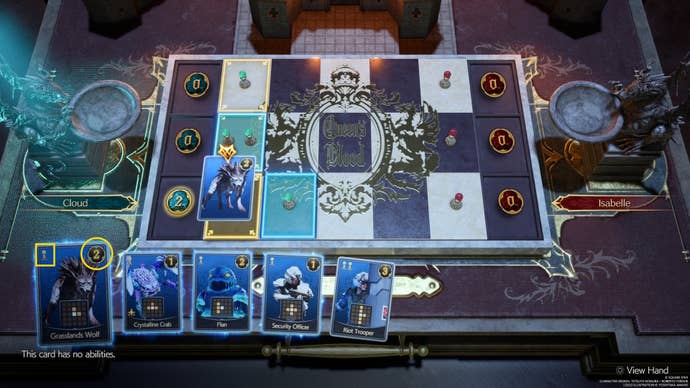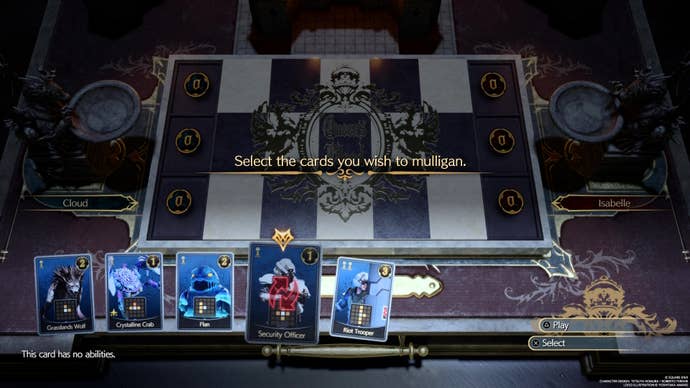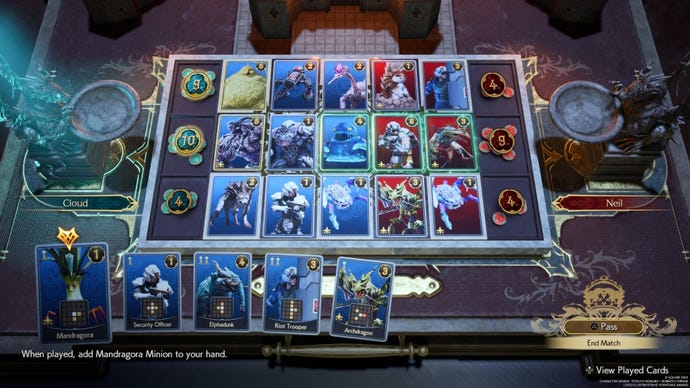Final Fantasy 7 Rebirth Queen's Blood tips and rules
For the queen
Final Fantasy 7 Rebirth's Queens Blood is deeper than you might expect from an optional card game, and the comparatively sparse tutorial - and high learning curve - mean it's a bit overwhelming to just dive right in. It takes a little while to get the hang of the rules, and once you understand what to do, the real fun comes from figuring out which cards work together and building strategies around them.
Our Final Fantasy 7 Rebirth Queen's Blood guide breaks down how the card game works and offers some Queen's Blood tips to get you started.
Final Fantasy 7 Rebirth Queen's Blood
Final Fnatasy 7 Rebirth Queen’s Blood rules

The Queen’s Blood tutorial goes over the basics, but it’s not the easiest set of rules to pick up at first. You play Queen’s Blood on a board with five columns and three rows. Each card has a rank, represented by the number of pawns in the card’s upper left corner, and a point value, which is the number in the card’s upper right corner. Placing a card earns you points equal to its point value for the row the card is in – so, for example, putting the Riot Trooper card in the top row gives you two points for that row.
The catch is that your points only count if you have more points in a row than your opponent. If you have nine, and they end up with 10, you get zero points for that row.
Every card has an area of effect that extends out from the square you place it on, and that effect determines where you can place new cards – either by turning a blank square into a rank-one square or turning a rank one or two square into the next rank up. For example, the Security Officer card affects a square on either side of where you place it. If you place it in the left-most square in middle row, you’ll end up with a rank-two square above and below it and a rank-one square to its right.
How to get more cards in Queen’s Blood
You can purchase a few booster packs from every town’s item store for roughly 500 Gil, and each comes with a small handful of cards. They aren’t always worth using, but having more options to experiment and develop new strategies with is always a good thing.
You also earn at least one new card for winning against a Queen’s Blood opponent the first time. These cards are usually pretty good – better than the ones you can buy, anyway – so it’s worth playing at least one match with them to see if they’re a good fit for you.
Final Fnatasy 7 Rebirth Queen’s Blood tips
We've put together a few handy Queen's Blood tips to help ease you into the game.
Restarting is good
It’s okay to restart a match if it looks like you’re about to lose. Rebirth has no penalty for restarting – or for losing, for that matter, but restarting is much faster. You always get a chance to edit your deck before starting again, so it’s a good way to experiment with new cards and strategies as well. If it doesn’t work, restart, and shuffle the deck again.
Balance your deck

This might go without saying, but make sure you have a foundation of rank one cards, slightly fewer rank two cards, and even fewer rank three cards in your deck. The high-rank cards are match-changers, sure, but if you can’t actually create a situation that lets you play them, then you’re in trouble.
Read your cards
This is also potentially a given, but it’s worth saying anyway. Read your card descriptions – press the touchpad on the deck screen to check them out – and look at their area of effect. Basic cards are straightforward, with clearly marked areas of effect. Some status cards aren’t, though, and it’s easy to overlook the red status square amid the grey and yellow normal squares.
Consider your starting hand

Ideally, you want your starting hand to have at least one card that’s rank two or rank three. That gives you something to build toward and makes it easier to shape the board in a favorable way, instead of just throwing down every Mandragora and Mu that pops up each turn. Don’t hesitate to mark cards for replacement before the match begins if it looks like you’ll start with a weak hand otherwise.
Use status cards
Cards with status effects – the Cactuar’s point buff, for example – are essential in matches after you leave the Grasslands area, though it’ll probably take some practice to use them well. Almost every status card has some kind of quirky placement effect, such as Cactuar’s buff landing on the square diagonal to the card’s bottom-most area of effect or the Archdragon weakening the card directly in front of it, but stacking ranks diagonally behind it.

It’s okay to lose (some rows)
Since Queen’s Blood takes an “all or nothing” approach, you don’t have to try winning every row or even two. Sure, they might get four or five points for the top and middle rows, but if you manage to get 10 points and absolutely dominate the bottom row, then their gains won’t matter. Keep an eye on your opponent’s point totals, and adjust your strategy as the match unfolds.
Don’t overextend yourself
You might be tempted to focus on stretching your cards into the opponent’s playing area to try blocking them from placing their own cards. Unless you have a really lucky hand and can get a rank-two square down so your opponent can’t reclaim it, you’ll just play yourself into a corner. Your best bet is to build a solid foundation on your side of the board, so you can start building a point base in at least two rows, and then pick one row to branch out in to see if you can block your opponent from progressing.




.jpg?width=291&height=164&fit=crop&quality=80&format=jpg&auto=webp)

.jpg?width=291&height=164&fit=crop&quality=80&format=jpg&auto=webp)










